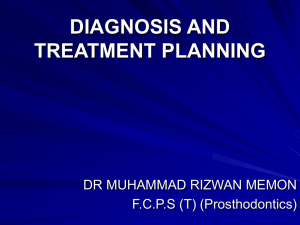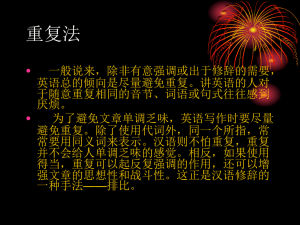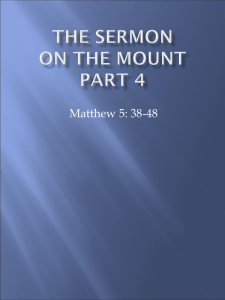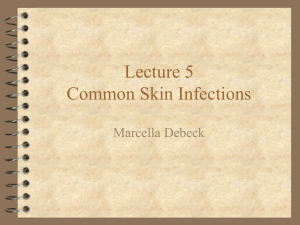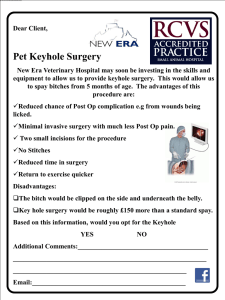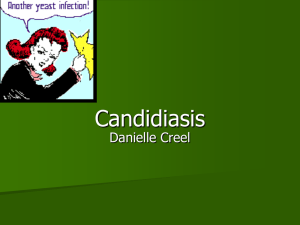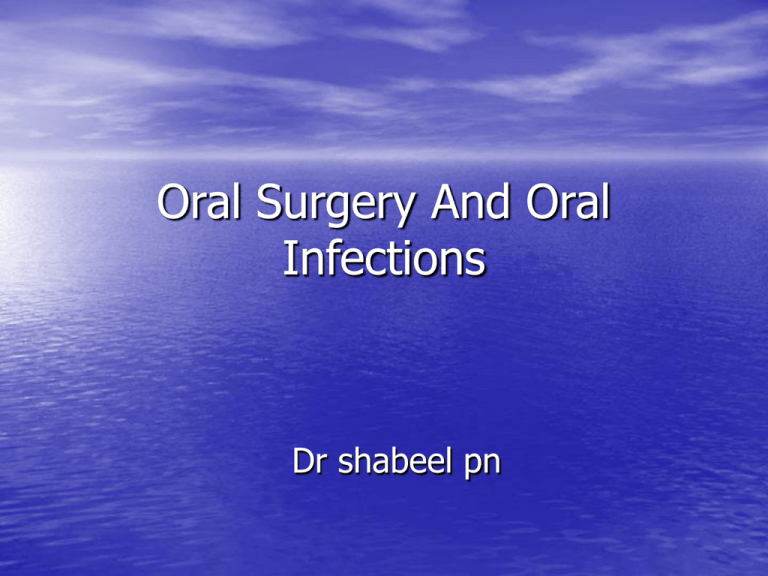
Oral Surgery And Oral
Infections
Dr shabeel pn
Oral Surgery
• Includes: The diagnostic and surgical
treatment of diseases, injuries, and
defects involving both the junctional and
the esthetic aspects of the hard and soft
tissues of the oral and maxillofacial
regions.
Types of Oral Surgery
•
•
•
•
•
•
•
•
•
•
•
•
•
Impacted tooth removal
Alveoplasty
Abscesses
Osteomyelitis
Fractures
Cysts, tumors
Dental implant placement
Maxillofacial prosthetics
Immediate denture
Facial esthetics
Cleft lip/ palate
TMJ disorders
Salivary Gland Obstruction
Patient Instructions
• Have the client use a soft tooth brush with a simple brushing
technique.
• Give instructions of prosthesis care.
• Recommend what to include and not include in the diet.
• Promotion of healing
Protein, vitamin A, C, and Riboflavin
• Tissue resistance
Diet variation including all food groups
• Provide instruction sheets for clients to take home.
• When instructing about diet, explain in quantity or servings.
Pre-surgical Instructions
• Explain procedures for anasthesia and surgery
• Explain alcohol and medication restrictions
• Some medications will interfere with the anasthetic and other drugs
provided during or after the treatment
• Assess whether the client will need transportation to and
•
•
•
•
from the appt. ie. when sedation is used…
Tell them to get a good nights rest the night before.
Wear loose and comfortable clothing.
Ask to remove contact lenses or any prosthesis.
Explain the number of hours before surgery the client
should stop their intake of food and liquid.
Post-surgical Instructions
• If bleeding persists, place a gauze pad or cold wet tea bag over the area for
•
•
•
•
•
•
•
•
•
•
½ hr. Bite firmly!
Don’t rinse for 24 hours.
After 24 hours rinse with warm salt water after brushing and every 2 hours.
Brush more thoroughly but avoid area of surgery.
Get at least 8 – 10 hours of rest each night.
Avoid strenuous exercise for the first 24 hours.
Don’t smoke for 24 hours.
Use a pain relieving medication prescribed by the dentist.
Apply ice pack 15 min on and 15 min off.
Include phone number the client can call after hours in case of
complications.
Do not suck from a straw for 24 hours
Diet
• Indications for a Liquid Diet
• Jaws wired together
• All clients who have a condition that makes it hard
to open their mouth
• Indications for a Soft Diet
• Client with no appliance or with a single appliance
• Client who has been maintained on liquid diet
throughout the treatment period.
Diet Planning Hints
• This is for the client who isn’t hospitalized
• Provide instruction sheets
• Explain nutritional needs in servings
• Show ways to vary the diet
• Suggest the limitation of cariogenic foods
Client Preparation
• Reduce the bacteria count
•
•
•
•
•
•
• Makes post-surgical infection less likely
Reduce inflammation
• Will lessen bleeding during surgery
• Promotes healing
Remove calculus
• Prevents interference with the placement of surgical instruments
• Prevents the breaking off of calculus
Instruct the client in personal oral care
Interpret dentists directions
Motivate the client who will have remaining teeth
• Prevents further tooth loss
A complete debridement should be scheduled for a few weeks after
surgery to insure the prevention of infection and assess tiissues.
• The DH or DA may participate in suture
removal, irrigation of the sockets, and
other post surgical procedures when the
client returns for his/her follow up.
DA’s Responsibilities
• Maintain a clear surgical field
• Observe vital signs
• Reassure the client and help them to relax
• Provide pre/post operative instructions
• Make follow up call
• DA MUST ASK IF THE CLIENT HAS TAKEN
PRE MEDS IF REQUIRED!!!
Holistic Approaches to OS
• Apply annatto after tooth extraction or gum surgery.
• Drink catnip tea or take in capsules to help you relax
•
•
•
•
before dental treatment
Use chamomile as a poultice for pain and swelling.
Soak a washcloth in warm comfrey tea and use as a
compress to relieve the pain of jaw and tooth fractures.
St. John's wort is given to people for neuralgic pains
after tooth extractions.
Use the fresh tops of shepherd's purse to help stop
bleeding after tooth extraction
Holistic Cont.
Use of Magnets can:
• Acceleration of growth of new cells (speeding up
wound healing processes)
• Suppression of pain (analgesic effect)
• Suppression of inflammation
• Widening of blood vessels
• Improving tissue flexibility
• Eliminating swelling
• Strengthening immunity
• Stimulating and stabilizing bone tissues
• Dramatic improvements in effectiveness of
prescription medication and supplemental
nutrients, vitamins and minerals
Infections related to Oral Surgery
• Osteomyelitis
• Pericoronitis
Osteomyelitis
• An inflammation of
the bone marrow that
produces pus and
affects the calcified
components of bone.
Causes
• 1. acute periapical infection
2.
3.
4.
5.
pericoronitis
acute periodontal lesions
trauma-fractures and extraction of teeth
acute infection of the maxillary sinus
How is it Diagnosed?
•
•
•
•
•
•
•
•
•
Complete blood count
Erythrocyte sedimentation rate
C-reactive protein
Needle aspiration or bone biopsy
X-rays
Radionuclide bone scans
CAT scans
MRI
Ultrasound
Signs and Symptoms
•
•
•
•
•
•
•
severe pain
regional lymphadenopathy
soreness of the involved teeth
if the infection involves the mandibular canal, a
paresthesia of the lip is common
On radiographs:
decreased density of trabeculae
multiple small radiolucent areas become
apparent
sequestra - irregular calcified areas separate from
remaining bone
Tx of Osteomyelitis
• Teeth should be extracted only when necessary
•
•
•
and antibiotics should be given prior to and
following the surgical procedure.
Massive doses of antibiotics, usually one of the
penicillin drugs, are given for at least six weeks.
A surgeon may perform a bone biopsy to see if
an abscess has formed on the bone. If an
abscess is found, antibiotics are given and
surgery is performed to remove the abscess.
If pus has formed, it is sometimes necessary to
drain the bone by drilling holes in it.
Tx Cont.
• Restrict the movement of the area as
much as possible.
• Monitored blood tests and x-rays.
Holistic Tx of Osteomyelitis
• Hepar sulphuris – pain, swelling, infection
• Chamomile -pain and swelling
• Witch Hazel – helps fight infections and
cleanses mouth
Pericoronitis
• Inflammation of the gingiva around a
partially erupted tooth.
• Resulting from debris accumulating under
the flap of tissue.
• Or from constant contact between the flap
and the tooth in the opposing arch.
• Usually occurs in teenagers and young
adults.
Pericoronitis Cont.
• Usually affects the
mandibular third
molars.
Signs & Symptoms
•
•
•
•
•
•
•
•
•
•
Pain when chewing
Bad taste
Trismus
Swelling in the neck and in the area of the tooth
Fever
Partially erupted tooth
Red inflammed tissue around the partially erupted tooth
Pus
Pain when touched
Enlarged lymph nodes
Treatment
• Irrigate under the flap of tissue with warm saline
•
•
•
•
•
solution.
Gently clean with a scaler
Instruct the client to rinse with warm saline
solution every 2 hours
Antibiotics
Surgical removal of the flap after antibiotic
therapy
Third molar extraction
Homeopathic Tx
• Dandelion is useful for treating abscesses in the mouth
• Combined with myrrh and licorice root, echinacea is
•
•
•
•
excellent for the treatment of abscesses in the mouth.
Rub eucalyptus oil or evening primrose on sore, inflamed
gums for temporary relief
Use a horsetail mouthwash to relieve mouth and gum
infections.
Red clover ointment can treat abscesses.
For pain and inflammation around wisdom teeth,
Belladonna is often given for throbbing pains and Hepar
sulph to promote expulsion of pus.
Other Oral Infections
• Herpes
• Thrush
What is Oral Thrush?
• It is an infection in the oral
cavity of yeast fungus, Candida
albicans. It affects the
mucous membranes of the
mouth. It causes white
patched in the mouth that can
be very painful and make
swallowing and chewing
difficult.
• Thrush effecting the
mouth and throat is also
known as oropharyngeal
candidiasis
How do you get Thrush?
• Thrush also known as Candida, does not
•
become a problem until the natural flora of the
mouth is disturbed, favoring candida over the
other microorganisms of the oral cavity.
This disturbance of the oral cavity can be caused
by a number of factors such as, taking
antibiotics, or chemotherapy. Systemic problems
can also cause an imbalance; diabetes,
malnutrition, drug abuse, or immune deficiencies
such as AIDS or deficiencies related to old age.
Thrush Cont.
• Those who have dentures that do not fit
well can suffer from breaks in the mucous
membranes of the oral cavity. This can
act as a gateway for candida. Those who
have suffered from this problem show
evidence of it when they have moist, pale
pink spots on their lips. These spots are
known as angular chelitis. This is a clear
indication of candida infection.
Symptoms of Thrush
• White cream coloured or yellow slightly
raised spots in the mouth.
• When the creamy substance is scraped
away wounds will be present and will
bleed slightly.
• A burning sensation may be felt in the
mouth and throat area.
Treatment
• Get the main condition that caused the thrush
•
•
under control.
Anti-fungal drugs will have to be either sucked
on or a liquid that must be held in the mouth
before swallowing to eliminate the fungus.
If it spreads or becomes complicated, systemic
treatment in the form of tablet or injection may
be needed.
Coping with the Symptoms of
Thrush
• Thrush can make the
•
•
mouth very sensitive,
this can make oral
hygiene very difficult
to maintain.
Use an extra soft
toothbrush.
It is also helpful to
rinse with a diluted
solution of 3%
hydrogen peroxide.
Foods to Avoid if you have Thrush
•
•
•
•
•
•
•
•
•
•
•
Yeast- breads, crackers, pastries
Fruit Juices- canned, bottled or frozen
Coffee and Tea- Regular, instant, decaffeinated. Herbal teas are tolerated
Caffeine- anything containing caffeine
Dairy or Dairy Containing Products
Black Pepper- hard to digest. Cayenne pepper is a recommended
alternative as it promotes digestion.
Any type of mushroom
Pickled and smoked meats, including sausages, hot dogs, corned beef,
pastrami, and ham.
Condiments, Sauces, and Vinegar-Containing Foods
Dried, candied fruits.
Leftovers, best to eat fresh foods due to mold growth.
Foods Recommended
•
•
•
•
•
Vegetables and Legumes
Fish/Shell fish, meat, poultry
Whole grains
Nuts
Fruits – avoid for 3 months then reintroduce 1 at a time on an
•
•
•
•
Seeds such as pumpkin, sesame and sunflower
Non grain such as Amaranth, buckwheat and quinoa
Butters (almond, sesame and sunflower)
Fats (Butters or unrefined oils
empty stomach
Herpes
• Herpes simplex is a common and usually mild
•
•
•
•
infection
A virus causes herpes
Causes cold sores or fever blisters on the mouth
and face
Once introduced to the body it will live there for
a lifetime
Often with periodic symptoms or no symptoms
at all
Herpes Symptoms
• Can take 4-6 weeks
•
•
to heal fully
May cause small
pimples or blisters
which will eventually
crust over and scab
May cause flu like
symptoms; fever,
swollen glands in
lymph nodes in the
head and neck region
How often will it occur? Why?
• depends upon the HSV type and how long the
•
•
•
infection has resided in the body
prolonged exposure to strong sunlight can
trigger oral herpes
individuals will discover what triggers outbreaks
in their own bodies
people who experience a strong initial outbreak
can expect to have several recurrences a year
How is it Spread?
• Skin to skin contact
• if you have a “cold sore” and kiss
someone, the virus will be transferred to
that person
• if you have a “cold sore” and have oral
sex, your partner will get genital herpes
Herpes Tx
• no treatment or medication that will cure herpes
•
but there is some to control it
3 most common meds: Acyclovir (Zovirax),
Valacyclovir (Valtrex) and Famciclovir (Famvir)
• Episodic therapy means taking the medication
•
only during an outbreak to speed up the healing
process
Suppressive therapy means taking antiviral
medication daily
Holistic Tx
• Whole olive leaves can be boiled in water or treated with
•
•
•
•
•
•
wine to make a remedy
carbohydrates from red marine algae is a low-cost, high
potential, broad spectrum antiviral agent
As a mild antiseptic, Sage will help heal coldsores
Rub tea tree oil directly on cold sores to promote healing
Use a salve made of thyme, myrrh, and goldenseal to
treat oral herpes
A mouthwash made from violet soothes coldsores
Capsicum, Dulcamara, Kali muriaticum, Kreosotum, and
Upas tiente all assist tin the relief of oral herpes.
The End



